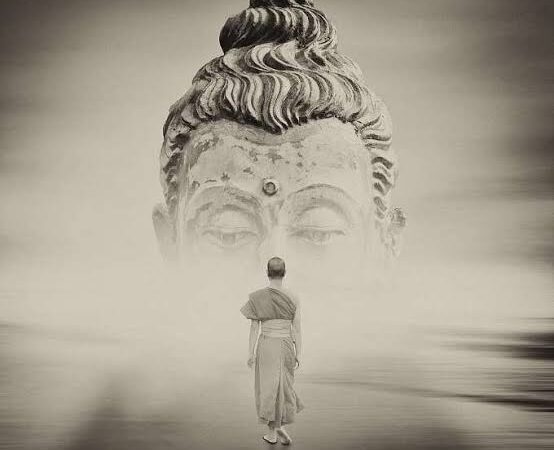Nagarjuna (c. 150 – c. 250 CE) is one of the most significant philosophers in the history of Buddhism. His works and teachings laid the foundation for the Madhyamaka (Middle Way) school of Mahayana Buddhism, profoundly influencing Buddhist thought across India, China, Tibet, Japan, and Korea.

Life of Nagarjuna
The historical details of Nagarjuna’s life are shrouded in mystery, with accounts varying widely. It is generally agreed that he lived around the 2nd century CE, although some sources suggest a broader timeframe from the 1st to the 3rd century CE. Nagarjuna is traditionally associated with the Satavahana dynasty, possibly serving as an advisor to King Yajna Sri Satakarni. This association places him in the Deccan region of India, particularly around the area of Amaravati
Despite the lack of concrete historical details, Nagarjuna’s influence is well-documented through his extensive philosophical writings and the reverence he receives in Buddhist traditions. His works are central to Mahayana Buddhism, particularly through their exploration of the concept of emptiness (śūnyatā) and dependent origination (pratītyasamutpāda).
Education and Monastic Life
From a young age, Nagarjuna displayed a remarkable intellect and a keen interest in learning. He initially studied the Vedas and various Hindu scriptures, given his Brahmin heritage. This traditional education would have provided him with a strong foundation in classical Indian philosophy and metaphysics (Wikipedia) (Internet Encyclopedia of Philosophy).
At some point, Nagarjuna transitioned from Brahminism to Buddhism, a significant shift that might have been influenced by his quest for deeper philosophical understanding and spiritual awakening. He became a monk and immersed himself in the study of Buddhist teachings. This period of intense study and practice would have involved mastering the early Buddhist scriptures, the Pali Canon, and engaging in rigorous meditation practices (Internet Encyclopedia of Philosophy) (LotusBuddhas).
Encounter with Mahayana Teachings
Nagarjuna’s encounter with Mahayana Buddhism marked a pivotal moment in his intellectual and spiritual development. Mahayana Buddhism, with its emphasis on the Bodhisattva ideal and the expansive philosophy of emptiness, provided Nagarjuna with a broader framework to explore the nature of reality.
He was particularly influenced by the Prajnaparamita Sutras, a collection of Mahayana texts that expound on the concept of śūnyatā (emptiness). These texts are said to have been revealed to him through a mystical experience, where he discovered them in the realm of the Nagas (serpent-like beings) beneath the ocean. This mythical account underscores the transformative impact these teachings had on his philosophical outlook (Internet Encyclopedia of Philosophy) (LotusBuddhas).
Philosophical Contributions
Madhyamaka School
Nagarjuna is best known for founding the Madhyamaka (Middle Way) school of Mahayana Buddhism. The Madhyamaka philosophy is characterized by its radical reinterpretation of the Buddha’s teachings on emptiness and dependent origination. Nagarjuna’s works form the bedrock of this school, emphasizing the middle path between nihilism and eternalism.
Emptiness (Śūnyatā)
Nagarjuna’s doctrine of emptiness is his most famous and influential contribution. Contrary to being a nihilistic view, Nagarjuna’s concept of emptiness asserts that all phenomena are devoid of intrinsic existence or inherent essence. This means that things do not exist independently but only in relation to other things, highlighting the interconnectedness of all phenomena. Emptiness is not the absence of existence but the absence of independent, permanent essence
Two Truths Doctrine
Nagarjuna articulated the “two truths” doctrine, distinguishing between conventional truth (samvriti-satya) and ultimate truth (paramartha-satya). Conventional truth refers to the everyday reality where objects and concepts are perceived as distinct and real. The ultimate truth, however, is the understanding that all these phenomena are empty of inherent existence. This dual framework helps bridge the experiential world with the ultimate reality, promoting a deeper understanding of the nature of existence without falling into extremes of nihilism or eternalism
Dialectical Method and Tetralemma
Nagarjuna employed a dialectical method known as the tetralemma (catuskoti), which systematically deconstructs all possible positions regarding the nature of reality. This method involves four alternatives: a proposition can be true, false, both true and false, or neither true nor false. By demonstrating the logical inconsistencies in these positions, Nagarjuna guides his audience to a non-conceptual understanding of reality, emphasizing the middle way between all extremes.


Major Works
Mūlamadhyamakakārikā (Fundamental Verses on the Middle Way)
This text is Nagarjuna’s magnum opus and a cornerstone of Madhyamaka philosophy. The Mūlamadhyamakakārikā systematically critiques various metaphysical views and establishes the principle of emptiness, providing a comprehensive analysis of the nature of reality.
Vigrahavyāvartanī (The End of Disputes)
In this work, Nagarjuna addresses criticisms of his philosophy, defending the concept of emptiness against objections. It explores the nature of perception and metaphysical problems, reinforcing the logical coherence of the Madhyamaka viewpoint.
Śūnyatāsaptati (Seventy Verses on Emptiness)
This text further elucidates the doctrine of emptiness, reinforcing the central tenets of the Madhyamaka school. It underscores that all phenomena lack inherent existence and emphasizes the importance of understanding emptiness to comprehend the true nature of reality.
Ratnāvalī (Precious Garland)
Written as advice to a king, this work blends ethical guidance with philosophical insights. It discusses the path to enlightenment and the principles of wisdom, compassion, and ethical conduct, aligning practical governance with spiritual development.
Other Works
Nagarjuna’s corpus includes several other significant texts, such as “Yuktisastika” (Sixty Verses on Reasoning), “Pratītyasamutpādahṛdayakārika” (Constituents of Dependent Arising), and “Bodhisambhāra” (Preparation for Enlightenment). These works collectively reinforce his philosophical doctrines and continue to be pivotal in Buddhist studies.
Nagarjuna’s Legacy
Nagarjuna’s philosophical contributions have had a lasting impact on Buddhist thought and practice. His articulation of the Middle Way, emphasizing the avoidance of extremes and the understanding of emptiness, has been integral to the development of Mahayana Buddhism. His works are still studied and revered, not only in Buddhist contexts but also in broader philosophical and academic circles.
Nagarjuna’s influence extends beyond philosophy into the practical aspects of Buddhist practice. His teachings on emptiness and the two truths provide a framework for meditation and ethical conduct, guiding practitioners toward a balanced and enlightened life. The dialectical approach he championed encourages critical thinking and a profound understanding of the nature of reality, making his teachings relevant across various cultures and eras.


Conclusion
Nagarjuna stands as a towering figure in Buddhist philosophy, whose teachings on emptiness, dependent origination, and the Middle Way continue to resonate. His works challenge conventional views, promoting a deeper, more nuanced understanding of existence. Through his profound insights and logical rigor, Nagarjuna has left an indelible mark on the spiritual and intellectual landscape of Buddhism, influencing generations of scholars and practitioners alike.
Related Videos
FAQ
Is Nagarjuna the second Buddha?
Nagarjuna is often revered as the “second Buddha” due to his profound influence on Mahayana Buddhism, particularly through his teachings on emptiness and the Middle Way, which significantly shaped Buddhist philosophy and practice.
Was Nagarjuna a Brahmin?
Who founded Vajrayana Buddhism?
Vajrayana Buddhism, also known as Tantric Buddhism, was not founded by a single individual but evolved as a distinct tradition within Mahayana Buddhism. It developed in India around the 6th-7th centuries CE, integrating earlier Buddhist teachings with tantric practices and rituals. Several key figures played significant roles in its development, including Indian scholars and adepts like Padmasambhava, who is credited with bringing Vajrayana to Tibet, and Nagarjuna, who contributed tantric texts and practices.
FOLLOW US ON




Pingback: Ananda, the Disciple of Buddha - buddhistpsy.com
if you like this article please visit – https://bclubb.es
I am extremely inspired together with your writing abilities as neatly
as with the structure on your blog. Is this a paid subject matter or did you customize
it yourself? Either way keep up the excellent quality writing, it is
uncommon to see a nice weblog like this one nowadays.
LinkedIN Scraping!